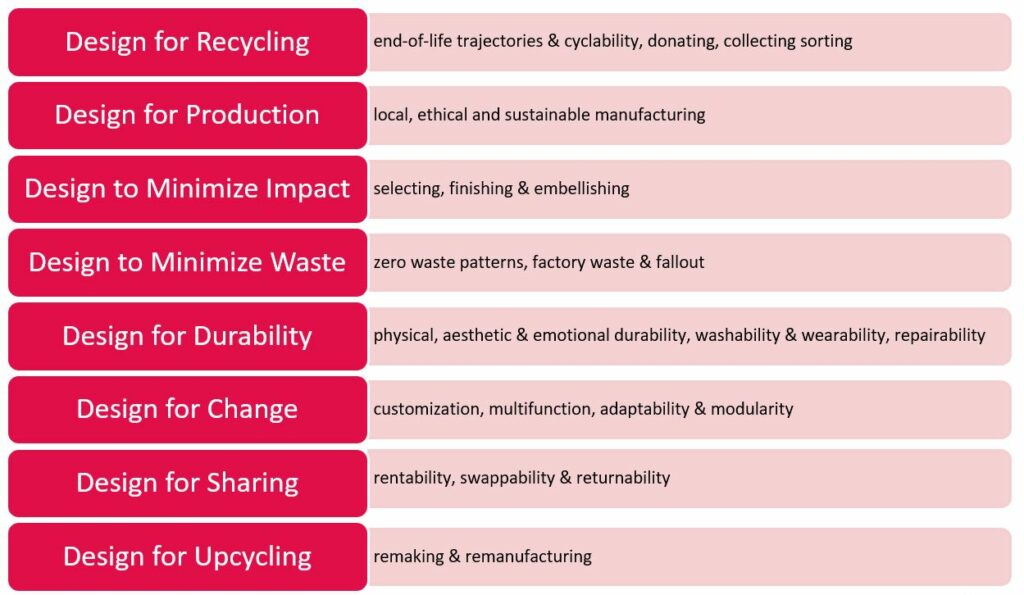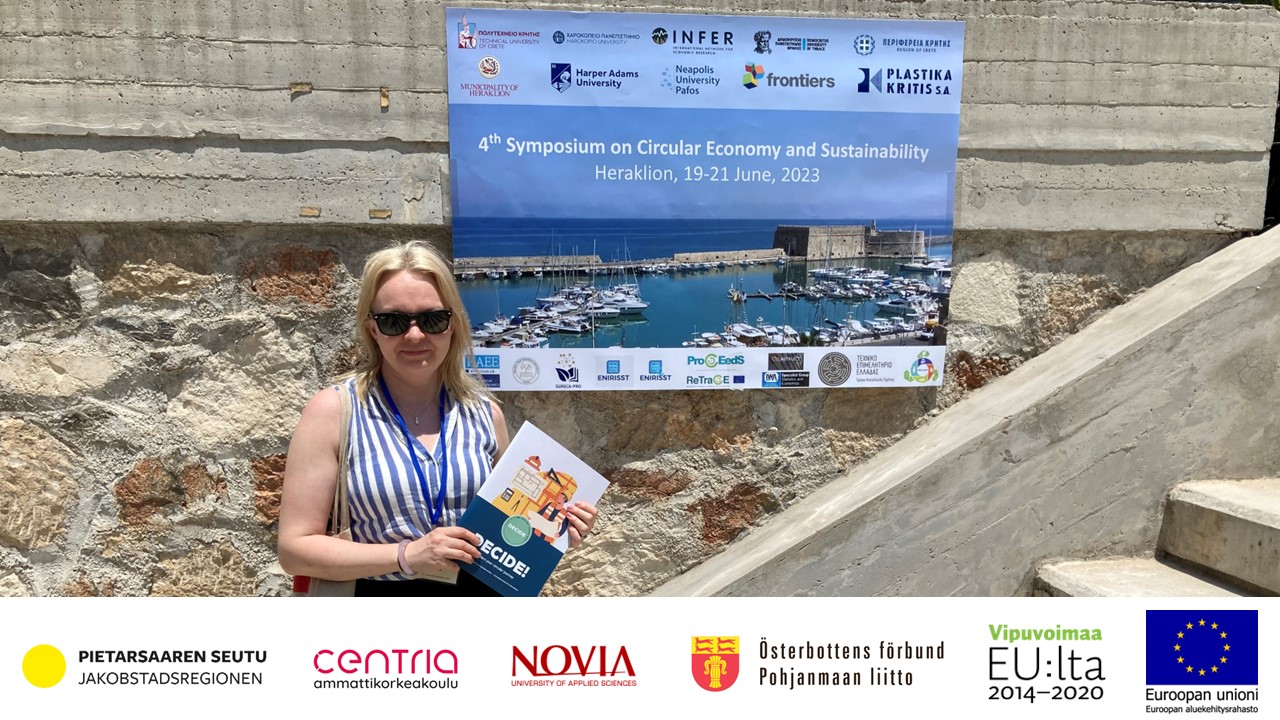Mira Valkjärvi
Weimu You
Egidija Rainosalo

The 4th Symposium on Circular Economy and Sustainability, held in Heraklion, Greece from June 19th to 21st, brought together researchers and scholars from diverse fields, all dedicated to exploring topics related to circular economy and sustainability. Centria’s staff from both RDI and business education took part in the conference.
Circular economy: single steps or a myriad of actors?
The event started off with welcoming words from the organizers and some welcoming words from the city of Heraklion. The first conference day had two keynote speakers, Dr. Jacqueline Cramer and Dr. Adisa Azapagic.
Dr Cramer discussed her research under the title of “Building a circular future: a Dutch comparative study on mattresses, concrete and textiles”. The key view of this talk was to highlight the complexity of circular solutions and their implementation. The research investigates the coordination of textiles within the textile cluster of the Netherlands. This hub included high value recycling technology, circular workwear, circular design and new bio-based materials and circular esthetics. The key learnings from this research were to outline the 10 guiding principles for network governance.

The second keynote of the day was by Dr. Azapagic. Her keynote focused more on the materials and emissions side of circular economy. One of the eye-opening points from her speech was considering how many parts a typical vacuum cleaner has, and how many of them are not actually required. The results showed that a vacuum cleaner has 150 parts in total, of which 41 were theoretically unnecessary. To come to this outcome, they reverse engineered a typical vacuum cleaner and found that the process of assembling a vacuum cleaner can have up to 313 repetitive tasks, require 116 tasks that involve tools and possibly have 104 tasks that add no value to the product. This really calls for a better focus on both circular and product design. In addition, this typical household item could be taken apart and reassembled, but many products out in the market do not necessarily have this quality. This could be a clever way of implementing circular design, by taking commonplace items and disassembling them to figure out not only what said item requires, what is necessary, but also to identify points in which to add more circular solutions. One way to approach this is to utilize the product evaluation procedure to identify circular economy opportunities through eco-design as suggested by Mendoza, Sharmina, Gallego-Schmid, Heyes & Azapagic (2017).
Another perspective of the keynote from Dr Azapagic was to discuss the life cycle impacts of single-use containers. The study compared polystyrene, aluminum, and polypropylene single-use containers. They decided to exclude cardboard from this comparison, perhaps this reveals the differences between material usage within different countries. Yet within this comparison between the chosen single-use containers, the results showed that all three materials had a significant impact on eutrophication, with polypropylene being the worst material by a long shot. Polystyrene in comparison to the other materials overall seemed to be the best option. Yet it is crucial to note that life cycle assessments (LCA) did not consider which material yields the best result in preserving the food they contain. Aluminum was the worst when considering resource depletion, human toxicity, marine ecotoxicity and ozone depletion. Additionally, among the materials, polypropylene had the biggest carbon footprint, eutrophication, and summer smog.
A common theme from the keynote as well as other presentations during the conference was that life cycle assessment is a means to evaluate a solution’s environmental impact or goodness. While many found that circular economy solutions should be measured by LCA, there seemed to be a disconnect between what factors imply circularity. Completing a LCA yields many different indicators such as climate change, resource depletion, eutrophication and so on. Yet quite a few seemed to share the belief that climate change was the only indicator for circularity. Such a thought seems to boil down to the thinking that circular economy is only recycling. In fact, however, it is a full-on transition in which our economic system moves towards a more nature focused means of operating. As such, all the indicators within the LCA should be considered when assessing circularity.

The first day then continued with simultaneous sessions in varying locations where the different participants and researchers presented their conference papers. The topics varied from waste management and recycling to circular strategies and business models. The evening was topped off with a gala dinner with delicacies from the region as well as folk dancing.
Life cycle assessment leading the way towards sustainability
On the second day of the conference the keynote speakers were Prof. Inmaculada Martínez-Zarzoso and Prof. Constantin Zopounidis. Unfortunately, the second keynote was cancelled due to unforeseen circumstances. The first keynote was titled: Towards Food Supply Chain Decarbonisation: Challenges of the European Policies and Stakeholders’ Initiatives.
The keynote speech focused on the food sector and specifically the food supply chain. The food supply chain is responsible for 21-37% of total GHG (greenhouse gas) emissions. The possible ways to reduce the emissions include actions such as reduce energy consumption, reduce leakage of high global warming potential refrigerants and new innovations that are aligned with the sustainable development goals. While these actions are not new in any sense, what struck us from this speech was the ability to follow how different countries have reached the sustainable development goals. The figure below shows the status of Finland regarding the sustainable development goals. As we can see Finland is doing well in goals 1, 4 and 7. These goals are 1 No poverty, 4 Quality education and 7 Clean and affordable energy. Yet so much more work is still required. See the map here for more details: Sustainable Development Report 2023 (sdgindex.org)

Circular design as a focal point in the transition towards Circular Economy
The third day was fully focused on the conference participants and their presentations. This was also the day that the experts from Centria presented their research titled: Value and the Circular Economy – A study on circular value-focused supply chains in remote areas. This study presented some of the results gathered from different circular economy related projects at Centria, including DeCiDe and EteVä Pilotti. During this presentation, the result of the DeCiDe project – the Kickstart your circular journey digital guide was also presented (c.f. Fleen et al. 2023). The presentation’s focal point was how to orchestrate circular activities of multiple actors within different yet complementing fields. The presentation tied nicely with other presentations and thoughts about orchestration and collaboration yet highlighting the importance of local actors and supporting their transition to circular economy. Perhaps one of the most important yet highly overlooked aspects of sustainability is in fact supporting local solutions and products. This should be one of the key issues when planning procurement and other purchases within organizations.

Some other thought-provoking ideas that were presented during the conference days included thoughts about circular design. Circular design was mentioned not only regarding the textile and food sectors as the keynotes had discussed, but also in fields such as construction and even sharing platforms. In relation to sharing platforms and services, one study found that the use of rental clothing apps, the kind where users intend to utilize the item once (not a monthly subscription) may be a more unsustainable choice. As an example, renting formal wear would normally include a person going to a rental shop, selecting the item, using it, returning it and the shop would clean the item appropriately. Yet moving this action online brings forth more questions about transportation, adding the need for logistics to receive and return the item, that may be used only once. Of course, this does not mean online sharing platforms could not work, but perhaps the timeframe and usability should be assessed when designing a business model.
But then how do we approach circular design? One view is to consider the various aspects of design in textiles as illustrated in the figure below, especially focusing on materials selection according to their end-of-life trajectories (Earley, Forst, Sandu & Spataru 2023).

While the above listing of acts is in a way generalizable for any field, other perspectives are more tied to the textile industry. So, what should others do? One perspective to this found from a presentation into design within the construction field suggested the following:
- Proclaim responsibility towards the environment
- Materialize future-oriented solutions
- Deal with multi-headed monster
- Orchestrate ecosystems
The first refers to resource focused activities, from being responsible when considering materials being used to also educating about which resources are good and bad. The second refers to innovation, enabling multi-cycle material usage and choosing the appropriate design strategies. This is quite an important factor to consider as within the construction field, it is quite common for structures to be torn down violently and to lose materials in the process that could have been utilized. In addition, most structures built have not been designed to be disassembled. The third, and most catching step is about measuring circular impact, complying with regulations, and managing information flows. This can be seen as a monster as for many companies having appropriate financial indicators may be tricky and to add on top of that tools to measure environmental or further sustainable indicators can seem like a monster. Finally, perhaps another key takeback from the entire conference is the importance of collaboration and ecosystems, how to get others involved and working together. For this step, the focus should be on defining the circular goals, creating solutions with partners, and integrating solutions throughout the system. (Anastasiades, Dockx, van den Berg, Rinke, Blom & Audenaert 2023.)
Perhaps the final thought that we wish to leave the readers of this article with is the thought that came from a presentation of circular design within the construction field, which resonates well with most Finns regarding nature:
Nobody can claim ownership of any materials – the earth belongs to everyone.
The idea that everyone has the right to roam within forests and collect berries from them is a key principle within the circular economy that we have not yet discovered. Perhaps circular economy is all about returning to a more nature focused and timed society.
See more about the conference here: https://4th.circulareconomy2050.eu/
References
Anastasiades, K., Dockx, J., van den Berg, M., Rinke, M., Blom, J., & Audenaert, A. (2023). Stakeholder perceptions on implementing design for disassembly and standardisation for heterogeneous construction components. Waste Management & Research, Vol. 41(8), 1372-1381.
Cramer, J. (2023, June 19). Building a Circular Future A Dutch comparative study of mattresses, concrete and textile [Conference presentation]. 4th Symposium on Circular Economy and Sustainability. 19-21 June 2023. Heraklion, Greece. https://easychair.org/smart-program/4thCESUST2023/2023-06-19.html#talk:225732 Accessed: 31 October 2023.
Earley, R., Forst, L., Sandu, E. & Spataru, A. (2023, June 20). BioTEN BURRR: Exploring current use, reuse, repair and recycling practices for bio-based clothing towards guidelines for circular fashion designers [Conference presentation]. 4th Symposium on Circular Economy and Sustainability. 19-21 June 2023. Heraklion, Greece. https://easychair.org/smart-program/4thCESUST2023/2023-06-20.html#talk:220921 Accessed: 31 October 2023.
Fleen, M., Petrelius, I., Valkjärvi, M., Tölli, H., Arnautovic, A., Björkholm, M., Rajan, R. (2023). DECIDE! Kickstart your circular journey. Available at: https://net.centria.fi/wp-content/uploads/2022/08/Decide_ENG_komprimerad-fil.pdf Accessed: 31 October 2023.
Mendoza, J. M. F., Sharmina, M., Gallego‐Schmid, A., Heyes, G., & Azapagic, A. (2017). Integrating backcasting and eco‐design for the circular economy: The BECE framework. Journal of Industrial Ecology, Vol. 21(3), 526-544.
Sustainable Development Solutions Network. (2023). Sustainable Development Report 2023. Available at: https://dashboards.sdgindex.org/map/goals/sdg12 Accessed: 31 October 2023.
Mira Valkjärvi
RDI-Specialist
Centria University of Applied Sciences
P. +358 50 571 2082
Weimu You (PhD, MSc, FHEA, PGCAP, AmO)
Head of Degree Programme in Business Management, Principal Lecturer
Centria University of Applied Sciences
P. +358 40 500 2726
Egidija Rainosalo (PhD)
RDI-Coordinator
Centria University of Applied Sciences
P. +358 44 725 0264


